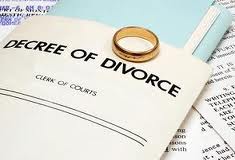Certificate of Divorce (Diviorce and Remarriage, Episode V)

The Certificate of Divorce is a Biblical License to Remarry
It is not proper to consider divorce and remarriage separate from each other; they are intrinsically connected. That is to say: one reflects the other. The certificate of divorce is the necessary license to contract another marriage: “And when she is departed out of his house, she may go and be another manʼs wife” (Deuteronomy 24:2).
Thus, remarriage is only valid if there was the issuance of a legal "Certificate of Divorce."
The "Certificate of Divorce" was nothing more than a written notice, placed into the hands of the wife by the husband, denouncing her as his wife. Bible scholars feel they have an example of just such a “Certificate of Divorce” in Hoseaʼs statement from Hosea 2:2; for that prophet says of Gomer, his unfaithful wife: “... she is not my wife, neither am I her husband.”
This written piece of paper, given by the husband into the hands of the wife, freed her from all obligations of the marriage contract and allowed her to become the wife of another man. Without the Certificate of Divorce she was condemned to fend for herself in an unfriendly environment; where, too much of the time, a woman merely “put away,” but with no Certificate of Divorce, could only survive by prostitution or begging, and most generally the two went hand in hand.
It seems clear that the hearts of the Jews had grown hard toward their wives, to the extent that they would “put away” their wives without a writing of divorce. Any woman so “put away” was still legally bound by the “law of the husband” which is spoken of by the apostle Paul in Romans 7:1-3, but was without her husbandʼs protection and care. This was unjust and abusive. It was this hardness of the husbands’ hearts that caused the Holy Spirit, through Moses, to institute the law of divorce, which was for the specific purpose of making right this wrong. At the same moment, the “Certificate of Divorce” removed the stigma that society attached on the spurned wife, by restoring her to society as a whole and complete person.

Moses and Jesus Are Agreed
Moses foretold of a prophet like unto himself that would come up from Godʼs people, a prophet whom they would hear: “The Lord thy God will raise up unto thee a Prophet from the midst of thee, of thy brethren, like unto me; unto him ye shall hearken;" ... "I will raise them up a Prophet from among their brethren, like unto thee, and will put my words in his mouth; and he shall speak unto them all that I shall command him” (Deuteronomy 18:15, 18).
The apostle Peter identifies this prophet, that was to come, as Jesus of Nazareth: “For Moses truly said unto the fathers, A prophet shall the Lord your God raise up unto you of your brethren, like unto me; him shall ye hear in all things whatsoever he shall say unto you. And it shall come to pass, that every soul, which shall not hear that prophet, shall be destroyed from among the people. Yea, and all the prophets from Samuel and those that follow after, as many as have spoken, have likewise foretold of these days. Ye are the children of the prophets, and of the covenant which God made with our fathers, saying unto Abraham, And in thy seed shall all the kindreds of the earth be blessed. Unto you first God, having raised up his Son Jesus, sent him to bless you, in turning away every one of you from his iniquities” (Acts 3:22-26).
Jesus says of Himself that He had not come to destroy the law but to fulfill it: “Think not that I am come to destroy the law, or the prophets: I am not come to destroy, but to fulfil” (Matthew 5:17).
Since these two things are true of Jesus (i.e. 1. He is the promised Prophet like unto Moses, and 2. He did not come to abrogate the law or prophets but to fulfill them), we should expect Him to support the moral teachings of Moses; or to at least show the law’s ultimate fulfillment in Himself. Indeed, that is what we find in the matter of divorce and remarriage. Jesus and the Lawgiver (Moses) are agreed.
Moses had written that if a husband finds some uncleanness in his wife, which causes her to lose favor in his eyes, he could put her away by presenting her with a “Certificate of Divorcement,” and placing it into her hand. Thereby, she was free to go and become the wife of another man (Deuteronomy 24:1-2). Likewise, Jesus allows for one to “put away” (divorce) his or her spouse for the cause of fornication: “I say unto you, Whosoever shall put away his wife, except it be for fornication, and shall marry another, committeth adultery...” (Matthew 19:9)
What most overlook (but we will point out) is that according to Jesus: If fornication was the cause of the divorce, both parties (i.e. the guilty, as well as the innocent) are free to remarry without the remarriage being considered a state of adultery. This puts, forever, to rest the false teaching of many groups that ONLY the innocent party may remarry.
Therefore, Moses and Jesus are agreed; the Old and New Testament are agreed. This is true because the law of Moses on divorce and remarriage is a moral law. Unlike civil or ceremonial laws, moral laws are immutable.

Certificate of Divorce Nullifies the “Law of the Husband”
In Romans 7:1-3 the apostle Paul introduces a law which he calls the “Law of the husband.”
“Know ye not, brethren, (for I speak to them that know the law,) howthat the law hath dominion over a man as long as he liveth? For the woman which hath an husband is bound by the law to her husband so long as he liveth; but if the husband be dead, she is loosed from the law of her husband. So then if, while her husband liveth, she be married to another man, she shall be called an adulteress: but if her husband be dead, she is free from that law; so that she is no adulteress, though she be married to another man.”(This “Law of the husband.” will be covered in more detail in a future article.)
According to Paul, the “Law of the Husband” binds a wife to her husband until his death. If she marries another man while her husband is living she shall be an adulteress. In plain terms: a woman could not have two living husbands. (Which in itself is interesting, in that a man could have plural wives without being an adulterer.)
The certificate of divorce, however, written by the husband and placed into the hand of the wife, dissolved the marriage contract; annulled the covenant and freed the wife from the “law of the husband” (Romans 7:1-3). The Hebrew word for the “Bill of Divorcement” is “keriythuwth” (Strongʼs #OT 3748) meaning: literally, cutting away of the matrimonial band. This word has its root in the Hebrew word for covenant (Strongʼs #OT1285) meaning: to bind, or confederate by cutting.
The graciousness of the “Bill of Divorcement” is seen in the fact that it freed a wife from the authority of a husband, in whose eyes she no longer found favor. Although the marriage is a covenant (beriyth), in that the man and the woman became one flesh, the “Bill Of Divorcement” is truly “a writing of excision;” by which the woman is cut off from the one whole. The word used to describe this is keriythuwth; it is a strong word that leaves no room for debate concerning its meaning. Namely, the matrimonial band is “cut away” by the strength of the writing, which is placed in the wifeʼs hand by the husband.
As of this point in our study, we have seen how Moses wrote that a husband may present to his wife, in whom he has found some uncleanness, a “Certificate of Divorce;” by the means of which, she would be a free agent to contract a new marriage with another man. This remarriage would NOT brand her with the stigma of an adulteress. Likewise, Jesus taught that if one divorced from his/her spouse because of fornication and married another, adultery would not be committed (see Matthew 19:9). It must be acknowledged that the “except clause” of Matthew 19:9 (i.e. “except it be for fornication”) reveals the following:
If one divorces his or her spouse, because the spouse has committed fornication, and marries another, that one is not sinning; and, If one has been unfaithful and is put away (divorced with a “Certificate of Divorce”) by his or her spouse because of fornication; then, afterwards goes and remarries another; that one is not in a state of adultery by virtue of the remarriage. ~ This fact is a clear indicator that neither fornication nor adultery are the unpardonable sins.
In Jesusʼ example, given in Matthew 19:9, it is a wife that is in view. Although, the same would be true of a husband.
Seeing, as we have, that the Scriptures teach what has preceded, one may be confused and see a contradiction between The Law of the Husband (Romans 7:1-3), and the liberty to remarry given by both Moses, and Jesus, to a woman found guilty of some uncleanness (Deuteronomy 24:1-4; Matthew 19:9 respectively). The Law of the Husband states that a wife may not leave her husband and become married to another man as long as her husband is living (Romans 7:1-3). While both Moses, and Jesus, taught that a woman in whom has been found some uncleanness (Jesus identified fornication), may be divorced to become the wife of another man—without becoming an adulteress It may seem logical to ask: How can both be true?
As forbidding as this quandary may seem, the solution is really quite simple: namely, the “Certificate of Divorce” makes the “Law of the Husband” null and void. Clearly, the “Certificate of Divorce” is the legal instrument by which the marriage contract is dissolved.
Apostolically Speaking
☩ Jerry L Hayes
Own this book by Bishop Jerry today. Click on the link below for more information.

Read More From the Bishop on Divorce and Remarriage.
- Christian Divorce and Remarriage, Episode I
This series of articles answers the all consuming question: May a Christian divorce and remarry? This is the first of many article to come on the subject. Be sure to read them all. - Christian Divorce and Remarriage, Egalitarian (Episode II)
This article concludes the introduction to Christian Divorce and Remarriage. Here is discussed the egalitarian aspect of Divorce. - Marriage, As God Intended (Episode III, Christian Divorce & Remarriage)
This article examines the intention of God for marriage, in the beginning. What the Bible declares marriage to be is shocking to most. This is required knowledge for an understanding of divorce. - Divorce and Remarriage, Words of Institution (Episode IV)
Moses sets forth the "Words of Institution" for divorce and remarriage. In this writing we will review those words in an expository study. - Biblical Grounds for Divorce and Remarriage (Divorce and Remarriage, Episode VI)
Here we explore the biblical reasons for divorce and remarriage. Many are convinced that the Bible gives no reason for divorce, others accept only 1, but this writer demonstrates. at least, 4. - Yahweh Hates Divorce? (Divorce and Remarriage, Episode VII)
Since the Bible states that God hates "Putting Away," it is important to harmonize this with God allowing divorce, and participating in it Himself. This article addresses that particular issue. - Biblical Examples of Divorce, Episode VIII
Examples are great teachers. A greater lesson can not be had that to witness how a biblical command was biblically executed. IN this study we will see just that in biblical examples of divorce. - The Biblical Status of the Divorcee, Episode IX
In this 9th episode on Divorce and Remarriage we examine the status of divorcees in the Bible. Here we answer the question: "What place does the divorced person hold in biblical society?" - The Words of Jesus On Divorce, Episode X
This article introduces all the words of Jesus concerning the subject of divorce. By this introduction of Christ's teaching on the subject we set a compass heading for further study. - The Apostolic Church, On Divorce - Episode XI
In this episode on divorce and remarriage we examine what the apostolic church (the Lord's church of the 1st century) had to say on the subject.








